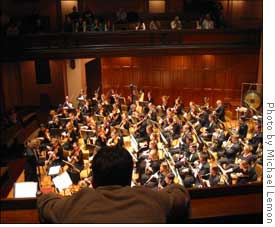| << Front page | Arts | April 16, 2004 |
Orchestra wows with Mahler
 |
||
| View from above: The Oberlin Orchestra performs Mahler’s Fifth led by Steven Smith on Tuesday night. | ||
Any performance of a Mahler’s Fifth Symphony is a massive event; its mere execution is something of a success in itself. On Tuesday, April 13 in Oberlin’s Finney Chapel and Wednesday, April 14 in Cleveland’s Severance Hall, the Oberlin Orchestra, under the direction of Steven Smith, presented a thoroughly impressive rendering of this concert hall warhorse. The concert also featured an effective performance of György Ligeti’s Atmosphères. The highly contrasting styles of these pieces highlighted some of the technical and musical strengths of the orchestra while allowing soloistic performances in the brass in the Mahler to shine through.
The first piece on the program, Atmosphères, composed in 1961, demonstrates some of the modern elements of less formal orchestral composition. Ligeti, a still-active composer of Romanian origins, spent much of his youth under the influence of the Soviet cultural regime that prevented him from accessing the modernist movements in classical music. Later, Ligeti immigrated to the West, where he was allowed more freedom to explore the forms and tonalities of “new music.”
Representative of Ligeti’s finest works, Atmosphères is often described as an attempt to reach stasis through constant movement. To achieve this affect, Ligeti scored the work such that, in some parts of the work, each individual string player has his own unique part, thereby attaining a total of up to 56 distinct voices. Because of the tightly-interlocking nature of the parts, however, no individual part is distinguishable from the mass of frenetic energy. The overall effect is that of colors rising and fading as the timbres change, but throughout the piece there is a sense of stillness composed of multiple active parts.
In general, Atmosphères, a tonally and rhythmically challenging piece, was well-executed by the orchestra. Despite occasional lapses in technical accuracy, the tone color and timbre changes were highly effective and shaped the piece musically. In a work in which the cardinal sin is being audible as an individual, the orchestra generally avoided the common problem of sounding like a group of solo performers rather than a unified ensemble.
The other piece on the concert, Mahler’s Fifth Symphony, was the main attraction of the evening. Mahler is well-known, among other things, for expanding the scope and size of the symphonic orchestra. The Fifth Symphony is no exception to this rule, and Oberlin Orchestra stood up well to the task of producing the quantity and quality of sound associated with heavy Mahler works.
The piece itself is a juxtaposition of two seemingly-irreconcilable ideas: death and love. The first two movements are generally interpreted as references to death and grief. The first movement is based on a variant of a theme Mahler used in his Kindertotenlieder, or Songs on the Deaths of Children. The second movement also makes use of a variant of this theme, marked in the tempo of a funeral march. The third movement is based loosely on an Austrian folk dance, the Ländler, and significantly lightens the mood of the symphony. The fourth movement marks another departure, this time to extreme lyricism. One of Mahler’s most famous and popular works, this movement is frequently performed outside the context of the complete symphony.
The symphony closes with a contrapuntal and surprisingly cheerful Rondo. This movement is sometimes interpreted as an ironic statement, but the bright enthusiasm of the closing seems to indicate that, for once, Mahler really meant it.
Despite the extreme technical challenges presented Mahler, the orchestra produced a musically satisfying interpretation of a mature symphonic work. The solo trumpet, which began the piece by stating the main theme, had a prominent role throughout. The orchestra balanced the trumpet nicely and again the tone color shifts were extremely effective. While there were occasionally some minor flaws in ensemble and some obvious scrambling for the high notes, in general the performance was acceptably technically secure.
As always, the orchestra certainly managed to make the experience truly musical through their ability to build excitement and tension. The final two movements were especially vivid, moving from passionately lyrical to supremely merry. At the end of the work, the orchestra really got everything together; the brass choir was fabulous with the strings and woodwinds nicely supported them to an energetic and appropriate ending that did both credit to the work and the orchestra itself.
About us
Subscriptions
Advertising
|